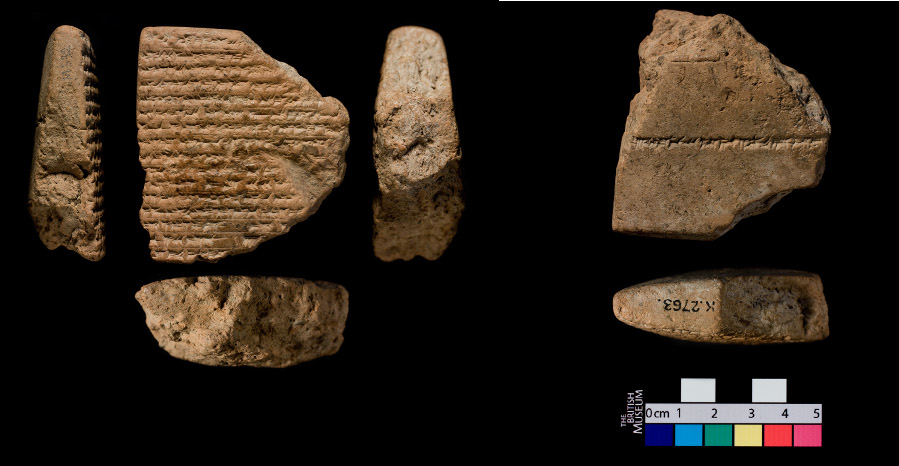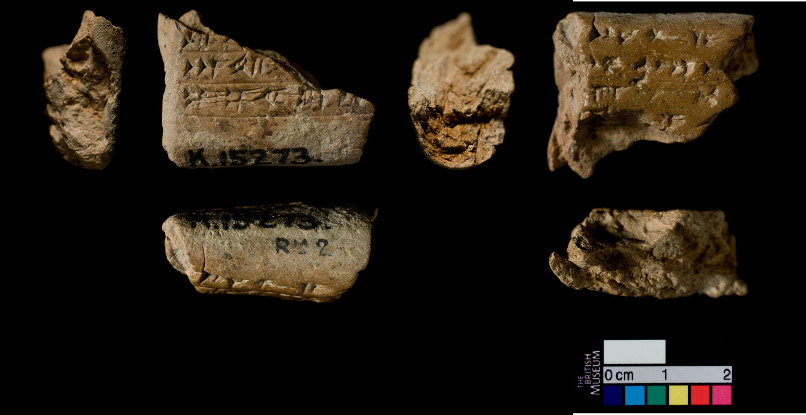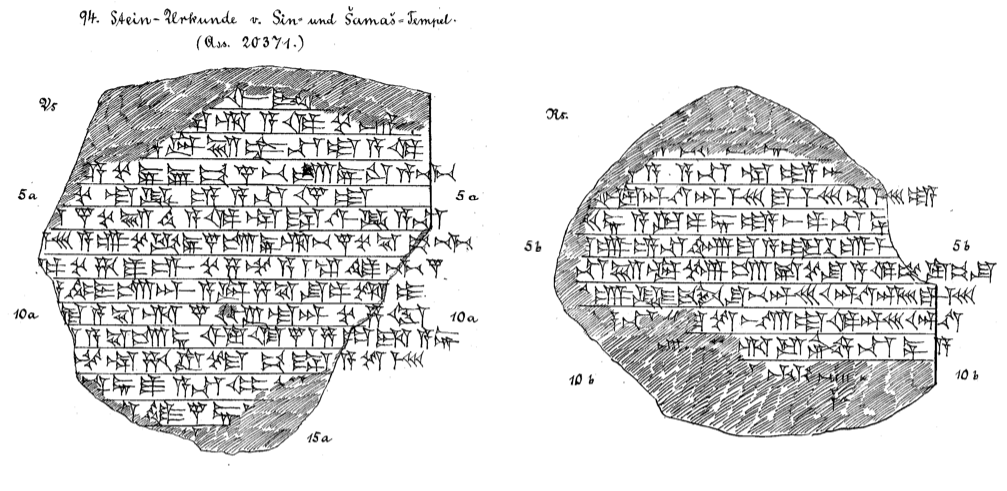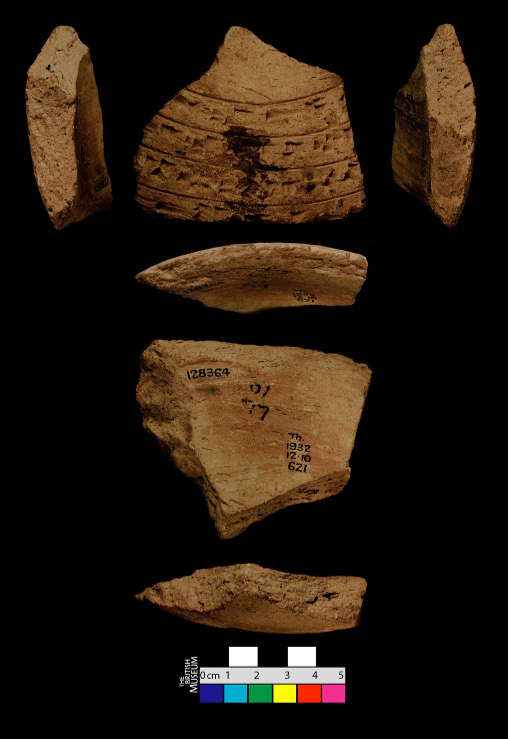Inscriptions, texts nos. 40-59
Browse the RIA 4 Corpus [/riao/ria4/pager/]
40 41 42 43 44 45 46 47 48 49 50 51 52 53 54 55 56 57 58 59
40
This text is often defined as the "Nineveh Standard Inscription,"
since, like the one from Nimrud (no. 23), this text is engraved over and over again with no significant variation on many reliefs from the Ištar temple at Nineveh. Texts nos. 41-44 are variant version of this text.
The inscription starts with a long passage dedicated to the king's name, titles and epithets, general description of his conquest in geographical order, and his genealogy (lines 1-27). The rest of the text is completely dedicated to the Ištar temple: a passage (lines 28-37) is dedicated to the cutting down of logs in the land Meḫru for the roof of Ištar's temple Emašmaš and Ashurnasirpal's palaces. The description of the reconstruction works mentions the fact that a Šamšī-Adad (might be both I [/riao/ria1/oldassyrianperiod/samsiaddudynasty/samsiaddui/index.html] and IV [/riao/ria4/shamshiadadiv/index.html]) had worked on this temple before. The inscription ends with a section of blessings and curses (lines 38-44).
Access the composite text [/riao/ria4/Q004494/] of Ashurnasirpal II 40.
Bibliography
41
Some fragments of stone slabs found in the Ištar temple and Ashurnasirpal palace at Nineveh bear a text which is a variant of the "Nineveh Standard Inscription," text no. 40, i.e., a part for the titles and genealogy section, the two texts are duplicates.
Access the composite text [/riao/ria4/Q004495/] of Ashurnasirpal II 41.
Bibliography
42
Two stone slabs from the Ashruansirpal palace at Nineveh bear an inscription which is a variant of the "Nineveh Standard Inscription" (no. 40), i.e. a part for the titles and genealogy section, the two texts are duplicates.
Access the composite text [/riao/ria4/Q004496/] of Ashurnasirpal II 42.
Bibliography
43
A broken text from a squeeze (now destroyed) taken from a stone object presumably found in the Ištar temple at Nineveh, is, according to Grayson (RIMA 2, p. 312) a variant of text no. 40, the "Nineveh Standard Inscription."
Note the following parallel lines:
Lines 1'-6' and text no. 40: 1-5
Lines 10'-13' and text no. 40: 7-11
Line 14' and text no. 40: 17-18
Lines 15'-20' and text no. 40: 20-24
Lines 23'-24' and text no. 40: 25-26
Access the composite text [/riao/ria4/Q004497/] of Ashurnasirpal II 43.
Bibliography
44
A piece of a stone slab from the Ištar temple at Nineveh is
inscribed with a very fragmentary text, which seems to be a variant of
the "Nineveh Standard Inscription" (no. 40)
Note the following parallel lines:
Line 2' and text no. 40: 3
Line 3' and text no. 42: 1-2
Lines 4'-6' and text no. 40: 22-27
Access the composite text [/riao/ria4/Q004498/] of Ashurnasirpal II 44.
Bibliography
45
Some stone slab fragments from the Ištar temple at Nineveh are inscribed with an abbreviated version of the construction account on this temple by Ashurnasirpall II.
Access the composite text [/riao/ria4/Q004499/] of Ashurnasirpal II 45.
Bibliography
46
Two fragments of stone from Nineveh, which do not physically join, but could indeed be part of the same slab are inscribed with a text that seems to concern the works on the Ištar temple at Nineveh. The object's location is currently unknown.
Access the composite text [/riao/ria4/Q004500/] of Ashurnasirpal II 46.
Bibliography
47

K 2763 (ex. 1) © The Trustees of the British Museum.
Two clay tablets from Nineveh bear copies of an inscription originally carved, as it is explicitly stated at the bottom of both tablets, on a statue of Ashurnasirpal II, the original of which has not been discovered. The fragmentary text begins with an invocation to various deities, followed by king's name, his titles and the beginning of a description of his conquests. Text no. 48 might be part of the same inscription.
Access the composite text [/riao/ria4/Q004501/] of Ashurnasirpal II 47.
Bibliography
48

K 15273 © The Trustees of the British Museum.
A small fragment of clay tablet from the Kuyunjik collection of the British Museum is inscribed with a copy of an inscription originally engraved on stone. This is possibly a piece of the same tablet edited here as text no. 47 ex. 1.
Access the composite text [/riao/ria4/Q004502/] of Ashurnasirpal II 48.
Bibliography
49
The fragment of a stone object stored in the Vorderasiatisches Musuem of Berlin, although of unknown provenance, should originally have come from Nineveh. The fragmentary text seems in fact to describe Ashurnasripal II's construction works on the Adad temple, and from elsewhere (text no. 66) it is known that the Assyrian ruler worked on the temple dedicated to this god at Nineveh.
Access the composite text [/riao/ria4/Q004503/] of Ashurnasirpal II 49.
Bibliography
50

Coffer (BM 135121) and ex. 2 (BM 090981) © The Trustees of the British Museum.
A stone coffer (H 35.56 cm x L 85.09 cm x W 48.26 cm) with two stone tablets was found at Imgur-Enlil, mod. Balawat, a few kilometers north-east of Nimrud. The two slabs bear the same royal inscriptions, whereas the box is engraved with an abbreviated form of the same text. A third stone slab was also excavated, but never published (see RIMA 2, p. 319 and Weidner AfO 18, p. 180).
The text begins with the royal name and titles and epithets (lines
1-20; cf. text no. 1 ii 125-131) followed by a description of Ashurnasirpal's works at Imgur-Enlil and the construction of a temple to its god Mamu (lines 21-33), including the decoration of the the temple gates with bronze bands (see texts nos. 50 and 80-97), and by a final section of blessings and curses (lines 34-49).
Access the composite text [/riao/ria4/Q004504/] of Ashurnasirpal II 50.
Bibliography
51

2008 Curtis, E. Sollberger's copies, pp. 140-143, Pl. 2.
This text was engraved on a number of bronze bands belonging to a
larger group found at site of
Imgur-Enlil, modern Balawat, which together formed the so-called
"Balawat Gates" of Ashurnasripal II, very similar to the "Balawat Gates [riao/ria5/shalmaneseriii/texts119/index.html#shalmaneser305]" of his successor, Shalmaneser III [/riao/ria4/shalmaneseriii/index.html]. The bronze bands edited here
were only inscribed and not engraved with images. The inscription was
engraved twice, therefore having two exemplars, one for each of the
two bronze covering which were fitted to the edges of the two leaves
of the gates at the point where they meet (see reconstruction
above).
The other bronze bands found at the site were originally attached to
the front of the gates and bore numerous scenes with relative
captions, here edited as texts nos. 80-97
The present text begins with royal name, titles and summary of conquests (parallel to text no. 1 iii 113b-126a), and is followed by a brief description of the works at Imgur-Enlil, the building of a wall and palace, and the installation of the doors that were decorated with these bronze bands.
Access the composite text [/riao/ria4/Q004505/] of Ashurnasirpal II 51.
Bibliography
52

KAH 2, 94
A broken stone slab found at Ashur is engraved with an inscriptionî concerning the works on the temple of Sîn and Šamaš. The first, fragmentary, part of the text, which includes royal name, titiles, epithets and summary of conquests, can be restored in parallel with text no. 53.
Access the composite text [/riao/ria4/Q004506/] of Ashurnasirpal II 52.
Bibliography
53

KAH 1, 25
Tens of stone block from Ashur and a clay tablet from Nineveh with extracts from royal inscriptions of various kings (see also text no. 21) bear this inscription describing Ashurnasirpal II's conquests in rough geographic order.
Access the composite text [/riao/ria4/Q004507/] of Ashurnasirpal II 53.
Bibliography
54
A stone foundation box found at Apqu-ša-Adad (modern Tell Abu Marya) might have originally contained the gold and silver tablets, which were found at the same site and are edited here as text no. 70. The object's location is at the moment unknown and the inscription could not be collated. Grayson (RIMA 2, p. 327) suggests, on the basis of the translation given by Speiser (see bibliography below), that it is a duplicate of text no. 1 iii 113-132 (cf. also text nos. 26 and 51).
Access the composite text [/riao/ria4/Q004508/] of Ashurnasirpal II 54.
Bibliography
55
A piece of clay cone originally from Nimrud is engraved with a fragmentary inscription with a description of the conquests of Ashurnasripal II similar to (but not duplicating) other inscription from the same corpus.
Access the composite text [/riao/ria4/Q004509/] of Ashurnasirpal II 55.
Bibliography
56
Numerous clay cone fragments form the temple of Ištar at Nineveh are inscribed with a text recording the works of Ashurnasirpal II on that building. The text, which is similar to texts nos. 40-42, begins with royal name and epithets, with a brief summary of the king's conquests, followed by a description of the building of the temple, and final blessings and curses. In the building passage, mention is given to the works on the esame temple led by king Aššur-uballiṭ (text no. 1001 [/riao/ria1/kingdomofassyria/ashuruballiti/index.html#ashuruballit11001]). For the mention to the Bīt-natḫi see text no. 18.
Access the composite text [/riao/ria4/Q004510/] of Ashurnasirpal II 56.
Bibliography
57

BM 128364 (ex. 4) © The Trustees of the British Museum.
This text, like text no. 56, describes Aššurnasirpal II's work on the Ištar temple in Nineveh. It is partially preserved on numerous clay cone fragments, although no complete exemplar has been found. The account given here is rather brief in comparison to that given in text no. 56.
Access the composite text [/riao/ria4/Q004511/] of Ashurnasirpal II 57.
Bibliography
58
This text is preserved on just one tiny fragment of clay cone, measuring 6 x 6.7 cm and found at Nineveh. While the inscription was presumably originally fairly long, only a very small portion remains and thus no translation is given here. The text concerns work on Bīt-natḫi, the Ištar temple in Nineveh (see also text no. 18 of this monarch). In this fragment Aššur-rabi II [/riao//ria3/ashurrabiii/index.html] is mentioned as a previous builder of the temple, as is also the case in text no. 65.
Access the composite text [/riao/ria4/Q004512/] of Ashurnasirpal II 58.
Bibliography
59
This fragmentary text gives information on Aššurnasirpal II's work on the Ištar temple in Nineveh. It is preserved on one piece of clay cone which was found at Nineveh and measures 7 x 8.5 cm. As such a small portion of the text is preserved, no translation is given here. For more information on this monarch's reconstruction of the temple, see text no. 56 [/riao/ria4/Q004510/] and its introduction.
Access the composite text [/riao/ria4/Q004513/] of Ashurnasirpal II 59.
Bibliography
Nathan Morello & Poppy Tushingham
Nathan Morello & Poppy Tushingham, 'Inscriptions, texts nos. 40-59', RIA 4: Inscriptions of Ashurnasirpal II, The RIA Project, 2023 [http://oracc.org/inscriptions/texts4059/]